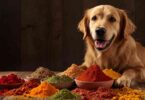Did you know 67 percent of pet owners confess to feeding their furry friends human foods? That latte topping may not sound harmful, but it is important to know the effects. This paper examines the issue of whether whipped cream is part of a balanced diet of the four-legged members of the family.
Veterinarians such as Dr. Dwight Alleyne insist on moderation when it comes to providing dairy-based snacks. Whipped cream is not toxic but has a lot of sugar and fat. Such components can lead to digestive disturbance or weight increase in the long run.
Small portions can be occasionally enjoyed by healthy animals that do not have lactose intolerance. Never miss labels that contain xylitol-a harmful sugar alternative in certain products. Homemade versions without artificial sweeteners make safer options.
Before adding new foods, pet parents need to consult their vet. Veterinary nutritionist Dr. Renee Streeter says treats should make up no more than 10 percent of daily calories. Future sections will discuss nutritional breakdowns, safe serving sizes, and substitutes such as Starbucks Puppuccino.
Understanding Whipped Cream: Composition and Ingredients
So what is it about that fluffy dessert topping that could be a problem to pets? Let’s break down its components. Whipped cream is a high-fat dairy product, heavy cream, whipped to airy heights. It is commonly sweetened with sugar and flavoring, such as vanilla, and contains 5 grams of fat and 50+ calories per two-tablespoon serving.
Nutritional Content and Added Sugars
Although human beings may be able to indulge in this every now and then, animals should be concerned with the high fat and sugar content. One serving of the dollop has almost 1 gram of added sugar. With time, regular use may lead to weight gain or metabolic problems. In contrast to nutritious snacks such as sweet potatoes, whipped cream has little vitamins or minerals.
Ingredients to Watch Out For
Xylitol stands out as a critical danger. This is a type of sugar substitute that is present in some sugar free types of sugar and it causes a fast release of insulin in pets. The ASPCA cautions that even minute quantities may result in life-threatening hypoglycemia. Never buy products that contain such words as birch sugar or wood alcohol. Artificial thickeners and preservatives may also irritate sensitive stomachs.
Choosing pet-friendly options starts with reading ingredient lists carefully. Look for simple formulas without hidden additives. In cases of doubt, discuss safer options with your veterinarian that would be specific to the needs of your companion.
Can Dogs Have Whipped Cream? What Pet Owners Should Consider
In the treatment of your companion, it is important to know his or her dietary requirements. Sometimes it may appear to be harmless to share whipped cream when making coffee runs or preparing desserts, but personal factors are important. The small body of a Chihuahua does not metabolize treats in the same way as a Great Dane, to take an example.
Dairy tolerance varies widely among animals. Others do not have problems with small amounts, whereas lactose-intolerant pups can develop gas or diarrhea. Pay attention to the response to the first portions-pain indicates that it is better not to eat dairy products in snacks.
Veterinarians stress that whipped cream lacks nutritional value. Unlike protein-rich training treats, it’s purely an indulgence. Consider this in your pet daily calorie intake to avoid obesity. Treats should complement balanced meals, not replace them.
Moderation remains key. One lick of your latte foam will not hurt most healthy adults, but regular portions accumulate. Always check labels for xylitol and artificial additives. Homemade versions using unsweetened cream offer safer alternatives.
Talk to your vet before allowing your dog to consume whipped cream, particularly in case they have allergies or chronic problems. Combine this recommendation with frequent health examinations to make sure that treats are in line with their health plan. Thoughtful choices keep tails wagging safely.
Health Implications: Benefits and Risks for Your Dog
Although that dollop of whipped topping may appear harmless, its impact on four-legged friends should be taken into account. Sometimes licks can go without any problems, yet frequent indulgence causes avoidable health issues.
Digestive Distress Signals
Rich dairy products often trigger temporary discomfort. Within hours, pets that ingest whipped cream may have loose bowels, gas, or vomit. These symptoms usually clear up in a day but show that there is poor digestion.
Chronic conditions such as recurrent diarrhea or abdominal pain should be treated by a veterinarian. Seniors and smaller breeds tend to react more because of sensitive systems.
Long-Term Health Concerns
Frequent treats contribute to weight management struggles. The pancreas which is an important organ in digestion is also strained by the high-fat content. Worked out glands can get inflamed causing painful pancreatitis that needs emergency treatment.
Xylitol-sweetened varieties double the danger. This additive leads to the quick drop of blood sugar and liver damage. Always verify ingredient lists before sharing human desserts.
A balanced diet remains essential. Treats like whipped cream should never replace nutrient-dense meals. Be alert to lethargy or change of appetite following intake- these are symptoms that require expert assessment. Thoughtful moderation helps pets enjoy occasional delights safely.
Veterinarian Insights and Safety Guidelines
What is the role of veterinary professionals in decision making of pet owners about treatment? Dr. Dwight Alleyne recommends: Start with a pea-sized amount of novel foods. Watch for 24 hours before offering more.” This cautious approach helps identify sensitivities early.
Expert Advice on Introducing New Treats
Veterinarians emphasize three rules for occasional indulgences. To start with, treats must not be more than 10 percent of daily calories, which is 20 calories in case of a 20-pound pet. Second, choose plain varieties without artificial sweeteners or flavorings. Third, introduce new foods separately to pinpoint reactions.
Dr. Stephanie Liff advises that dairy tolerance should be tested by giving a lick of plain yogurt before giving whipped toppings. She adds that, in case no digestive problems are observed after 12 hours, small quantities may be safe. Always consult your vet about individual dietary needs.
Considerations for Lactose-Intolerant Dogs
Approximately 40% of adult pets struggle to digest dairy. Lactose intolerance is signalled by such symptoms as excessive gas or loose stools. For these animals, even small quantities could cause discomfort.
Vets recommend other products such as coconut-based whipped toppings to sensitive pups. Never fail to read the label of the store-bought products that may contain some dairy derivatives. In case of doubt, avoid the treat and use vet-approved snacks.
Periodic visits can be used to check the effects of the eating habits on the long-term health. Talk to your vet to develop a safe dogs eat program that balances pleasure with nutritional concerns.
Exploring Puppuccinos and Other Whipped Cream Treats
Coffee houses have introduced a new trend in pet friendly indulgence. Drive-thru windows, patio tables, all the way to furry friends, now accompany their owners to enjoy specialty snacks. When carefully made, these offerings combine the social media attraction with the consideration of safety.
Starbucks Puppuccinos: A Special Treat for Your Pup
The famous Starbucks Puppuccino is made of whipped cream in a small espresso cup. This free product was invented by baristas to enhance customer attachment to pets. The single-serving portion allows owners to prevent overindulgence and allows pups to feel part of the fun.
Other chains such as Dunkin and Dairy Queen have similar offerings. Always request plain whipped cream without toppings or flavorings. Restrict these snacks to once a week in small breeds-their little bodies do not process sugar as well.
Homemade Alternatives and Safe Dairy Options
Lactose-free whipped toppings on coconut milk are good alternatives to sensitive stomachs. Chill coconut cream and add a pinch of cinnamon to make it taste good. Avoid artificial sweeteners, chocolate, and coffee additives that are poisonous to pets.
Portion control remains crucial even with homemade versions. Dollop into ice cube trays and freeze so you can easily have single-serving treats. Combine such occasional snacks with healthy exercise and vet-recommended meals to stay in the best shape.
How to Serve Whipped Cream Safely
To provide creamy indulgences, it is important to plan to ensure that tails are wagging safely. Pay attention to intelligent serving and ingredient knowledge to reduce the risks and allow pets to indulge in treats sometimes.
Portion Control and Moderation Tips
Begin with a teaspoon of serving per month on medium-sized pets. Smaller breeds should receive half this amount. A measuring spoon will prevent overfeeding during treat time.
Before sharing, always look at labels to see whether it has xylitol and artificial additives. Add a small spoonful to ordinary food as a special topping instead of serving it by itself. This helps prevent digestive upset while satisfying curiosity.
Monitor within 12 hours of consumption to watch out for vomiting, diarrhea, or lethargy. These signs suggest intolerance or overindulgence. In case the symptoms last more than 24 hours, call your veterinarian.
Keep in mind the 10 percent rule: no more than one-tenth of a day of calories should be in the form of treats. That is only 90 calories of extras such as whipped toppings in a 30 pound dog consuming 900 calories/day. Keep a food journal to track all the snacks.
Recognizing Unsafe Ingredients in Dog Treats
There are lurking dangers in ordinary treats most owners think are safe. Although pets may whine to get a bite of human food, some food additives make seemingly harmless foods into deadly substances. The section de-mystifies harmful ingredients and teaches furry friends how to read labels.
Spotting Sugar-Free Pitfalls and Additives
Xylitol tops the list of dangerous substances for pets. It is a sweetener found in baked goods, sugar-free gum and peanut butter, and it causes insulin spikes in toxic dogs. Even a small dose can cause vomiting, seizures or liver failure in a few hours.
Not all “sugar-free” products pose equal risks. Nuts n more is one of the brands that contain xylitol, but JIF and Skippy are safer. Be sure to read labels to avoid such terms as birch sugar or wood alcohol-code words for this poisonous additive.
Other additions that should be avoided are artificial preservatives such as BHA and food dyes. Sensitive pets can develop allergic reactions or digestive problems because of these chemicals. In selecting whipped cream or other such desserts, plain whipped cream without flavorings or thickeners should be selected.
Vet care is essential in case of toxic dogs that ingest poisonous substances. Watch for symptoms like lethargy or loss of coordination. Have emergency clinic numbers close by, particularly following the introduction of new products.
It is a good idea to read labels by all pet owners. Check the ingredients list across brands- natural proteins and vegetables are the best foods that safe dogs can live on, not processed additives. Knowledge transforms treat time from risky to rewarding.
Wrapping Up: Thoughtful Choices for Your Dog’s Treats
Every dollop matters when prioritizing pet health. Although whipped cream may be a treat, it should be saved as a special occasion treat. Tiny amounts reduce the chances of gastrointestinal distress or weight gain–never use products with xylitol, which is toxic to even safe dogs.
Veterinary experts stress moderation and ingredient awareness. Treats should complement—not replace—balanced meals. Homemade solutions with lactose free ingredients provide relief to sensitive pups. Whenever you want to add new foods, be sure to talk to your vet first, particularly when your companion has food restrictions.
Remember: no two pets share identical nutritional needs. What is good to one dog may result in digestive problems to another. Track reactions carefully and adjust treat choices accordingly. Opt for nutrient-rich snacks over empty calories whenever possible.
Educated choices will allow you to enjoy the special occasion without sacrificing health. With a little bit of caution and creativity, you will make happy memories that leave tails wagging safely in years to come.
FAQ
Is whipped cream toxic to pets?
Majority of the normal whipped cream is not poisonous, although some of the contents such as xylitol (sweetener) can be fatal. Before sharing, always read labels to see whether there are artificial sweeteners or additives.
How does lactose intolerance affect dogs?
Most adult pets do not have enough lactase enzyme to break down dairy. This can lead to vomiting, gas, or loose stools. Opt for lactose-free options if offering dairy-based treats.
Are small portions of whipped cream helpful to the diet of a pet?
It has no nutritional value, but small amounts every now and then will not hurt most healthy animals. Use sparingly as a training treat or pill-hiding aid.










Leave a Comment